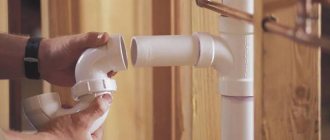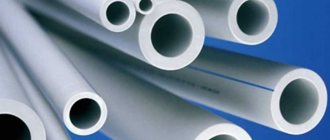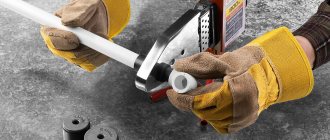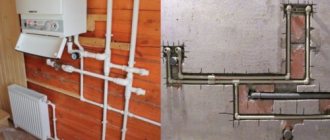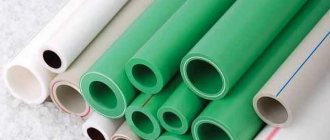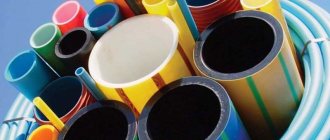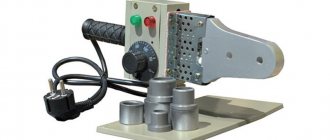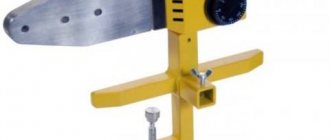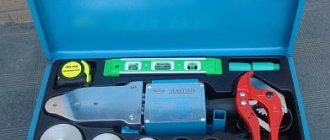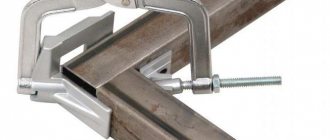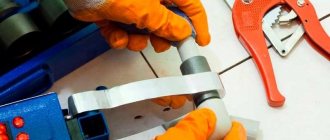The main features of plastic pipes include lower price and weight, increased service life, and ease of installation. Particularly noteworthy is the ability to connect pipes without soldering or with it, but in a faster way than metal analogues.
Let's figure out what options there are for connecting polypropylene pipes and how to apply various assembly technologies at home.
One way to connect a pipeline Source atyourserviceplumbingcompany.com
Polypropylene pipes: connection methods
The choice of technology for assembling a plastic pipeline depends on the type of products and their properties. The methods used for joining sections are divided into two large groups:
- The first one is “hot”.
This involves welding or soldering, that is, heating the material to change its state of aggregation. This method is used to form a deposit at the joint, and ensures the absence of leaks and uniform distribution of mechanical loads.
A welded joint is, first of all, a one-piece type of installation. This type of pipe connection is permanent and is used until the expiration date of the products. This method is more often used to achieve high pipeline strength. Soldering is done using special equipment or improvised tools.
Method of connecting polypropylene pipes by soldering Source vodatyt.ru
- The second is “cold”.
Involves connecting polypropylene pipes without soldering. This method is used when quick joining is necessary, in the absence of welding skills.
The installation method in this option is detachable or threaded. It can be used when connecting thin pipes, polypropylene and metal. When using this “cold” method, connecting elements are used - polypropylene fittings, the sizes and dimensions of which are selected to match the main product - pipes.
Knowing how to connect polypropylene pipes without soldering, you can pre-select elements suitable for operating conditions and ensure quick assembly.
Installation of polypropylene pipes using improvised means Source moikolodets.ru
Features of the use of metal products and polymer pipe products
The properties of any pipes, including metal ones, are determined by the characteristics of the material used for their manufacture:
- Cast iron was used to lay pipelines back in the not-so-distant Soviet times. It is still considered a fragile material. A cast iron pipe can easily be destroyed with one more or less strong blow. However, a product made from a relative novelty - High-strength Cast Iron with Nodular Graphite (abbreviated ductile iron) - has a level of impact resistance comparable to the value of this parameter of a steel pipe;
- steel. This material is susceptible to corrosion, and accumulations of dirt and impurities form on the inner surface of pipeline elements made from it;
- stainless steel It is still the most expensive metal, serving for many years, but difficult to process.
- Galvanized steel has proven itself to be excellent in terms of resistance to corrosion processes, but professionals note the difficulty of installing pipes made from it.
Plastic pipeline elements are also divided into several types:
- polypropylene parts. They do not require maintenance and are easy to install. Often sold out material;
- polyethylene are suitable for both water supply and sewerage;
- PVC products are used for laying autonomous sewers;
- metal-plastic pipe products.
“Hot” joining method: welding options
When using this method, 2 welding options are used:
- Soldering pipe to pipe is the most popular method.
- Fusion welding of couplings (adapters).
The first method is used when welding pipes with a diameter of more than 40 mm. The second is on pipes with a diameter from 16 to 40 mm. In this case, the fitting is needed not only to adjust the direction of pipe laying, but also as a supply of material for melting.
Various configurations of couplings (adapters) Source education-web.ru
Coupling configurations are selected based on the characteristics of the pipeline. The following types of adapters are available:
- Corners . Change of direction in any direction.
- Tees . Distribution of water supply and change of direction.
- Couplings . Docking without changing direction.
The following elements also apply:
- Bypass fittings.
- Ball valves.
- Combined products including metal-plastic.
- Threaded inside or outside pipes.
Tees, crosses
The main purpose of the products is to join/bend several pipe bends. They are characterized by different angles and configurations. In the case of a heating system, welded fittings equipped with a smooth internal threadless surface are well used. Less often, it may be necessary to switch to another type of material, then there are threads at the ends of the connections.
Transition tee
The use of a fitting is relevant when arranging a pipeline with a transition to a smaller diameter. The operating temperature is 95 degrees, the pressure is 2.5 MPa, the connection is provided by butt welding.
Combination tee with internal thread
The product is used for connections with reinforcing elements, faucets, plumbing fixtures or steel pipes in pipeline branch areas. Operating temperature 95 degrees, pressure 2.5 MPa, butt connection.
Male Tee
Used for joining PVC pipes with reinforcing elements and steel pipes when branching pipes.
Tees with union nuts
The design is used for dismountable threaded connections of PVC pipes with steel fittings or pipes when branching pipes in areas with cold or hot water supply. The maximum heating level is 80 degrees, pressure 2.0 MPa. The connection is formed using butt welding.
Mechanical joining method without soldering: connection options
Soldering as a method of joining pipeline sections is more often used during installation supervision in production. In everyday life, the most popular technologies are express installation without welding.
The time-tested practice of joining without the use of special tools ensures high quality joints of plastic pipes without soldering using couplings.
The widely known method is based on the use of shaped parts. With their help, you can not only ensure the continuation of the water supply circuit, but also change its direction, distribute the working medium or block the flow.
Advantages of installation technology without heating:
- Finished polypropylene products are cheaper to connect using this method than metal ones due to the low cost of fittings.
Connections of plastic pipes without soldering using couplings Source stroy-podskazka.ru
- The design of the fittings makes it possible to manually assemble a complete engineering system of drainage, water supply, and sewerage.
The size and technical capabilities of parts are determined by their configuration (shape, wall thickness, combination).
Connection using compression fittings
When choosing how to connect plastic pipes for water supply without soldering, many people often use the compression fitting method. With this connection method, the process of heating adjacent parts is eliminated. A special coupling, under mechanical action (crimping), reliably fixes the two ends of the tubes equipped with o-rings inside. After installing the adapter, the joints are lubricated with silicone sealant.
Switching from metal-plastic to polypropylene using fittings is an indispensable way to join pipes made of different materials.
The advantages of this method:
- a minimum set of tools is used for installation;
- Even a beginner can trust the pipeline connection;
An example of lubricant used when installing polypropylene pipes Source construct.smazka.ru
- a reliable connection is created at the installation site of the compression fitting;
This method, first of all, is good because it can be used when updating cast-iron water pipes with polypropylene analogues. This method is also in demand when assembling heating systems, including the installation of radiators.
Connection using adhesives
Among the docking options that make it possible to do without special equipment is the use of assembly adhesives.
The base composition of the adhesive is polyvinyl chloride mixed with a solvent. Manufacturers also add various additives and plasticizers to it to improve adhesion at joints.
Advantages of the method:
- joining products using an adhesive provides the assembled structure with the necessary characteristics of strength and tightness;
- upon completion of work, a reliable connection is formed at the installation site, invisible during visual inspection;
- No special skills are required for docking.
Important ! During work, safety precautions should be observed, do not work near open sources of fire and avoid contact of the composition with the skin.
Fitting polypropylene pipes before gluing Source www.asvshop.com
See also: Catalog of companies that specialize in engineering communications.
How to install with glue
Before connecting polypropylene pipes, you need to prepare the necessary parts, tools and provide conditions for installation work.
The surfaces on which the adhesive composition will be applied should be treated with a degreaser. To apply the composition, a brush with bristles made from natural materials is suitable. It is also recommended to ensure the room temperature ranges from 5 to 35 degrees.
Considering that the pipeline parts will be joined with a minimum gap, a thin layer of glue will be sufficient. Holding the pipes until they set usually does not exceed 20-30 seconds. Upon completion of work, it is recommended to ventilate the room well, while drafts should be avoided.
Using couplings
An ordinary coupling for plastic pipelines is a fairly simple part in its design. It consists of:
- cast iron body;
- two nuts;
- rubber gaskets;
- four metal washers.
The coupling can be found at the nearest plumbing store, or, if you have certain skills and knowledge, you can make it yourself. In this case, the characteristics of the coupling must strictly correspond to the dimensions of the products being connected. Ordinary couplings are suitable for both pressure plastic pipelines and pipelines without pressure. With their help, they provide a reliable connection of polypropylene without the use of a soldering iron.
To form a connection, the ends of the pipes must be inserted into the coupling so that they touch in the middle. The ends must pass through washers, gaskets and nuts. Then you need to tighten the nuts tightly so that the pressure on the gaskets is strong enough.
Joining plastic pipes with a coupling provides a 100% sealed seam, even without the use of soldering. But in certain cases, for example, if the pipe is short or adjacent directly to the floor (or other horizontal surface), it is not possible to install an ordinary coupling.
For such difficult cases, a clamping coupling was invented. How to use it? First you need to clean the edge of the plastic pipe. Then you need to unscrew the coupling and put all the fastening parts on the plastic product in the correct sequence. Moreover, the sealing ring should ultimately be located at a distance of at least one centimeter from the edge of the product.
Then you need to insert the body of the clamping coupling into the end of the plastic pipe. And then you need to move all the existing rings to this body and tighten the bolt. And to the thread located on the other side of the coupling, it will be necessary to attach an “American” fitting with a plastic pipe connected to it.
To control the strength of the connection, you must carefully pull the coupling towards you, holding the pipe to which it is attached with your free hand. The clutch must remain stationary
If it moves, it means that the wrong size part was selected. That is why it adheres so poorly to the pipeline. However, this is easy to fix - you just need to tighten the threads.
How metal-plastic and polypropylene pipes are joined
There is only one way to install pipes made of different materials. This is a threaded installation, since soldering and gluing products cannot be used here.
This is explained by the fact that the joint must not only be hermetically sealed, but also be able to experience high dynamic loads (maximum pressure difference).
Quick installation of pipes from various materials Source glawtruba.ru
Before connecting a metal-plastic pipe with a polypropylene pipe, you need to select the necessary parts:
- Metal-plastic products are equipped with special tips.
- Polypropylene sections, in turn, are equipped with a coupling on which a thread is applied.
Kinds
There is a wide range of pipes for water supply, each of which differs in its size and characteristics. Today, different types of plastic pipes are used, but the most common are:
- cross-linked polyethylene;
- PVC (polyvinyl chloride);
- metal-plastic;
- polypropylene.
Polymer products have better characteristics: they do not accumulate sediment, water moves almost silently through the pipeline, which prevents rust. Such products must be protected from damage. There are also several ways to connect products; in some cases it is necessary to use a special welding machine; sometimes it is enough to use couplings, collets, or use an adhesive composition.
Bell-shaped technology for assembling plastic pipelines
Fixation using this method is justified only when operating in low pressure systems. The insert into the socket ensures quick and easy installation, suitable for sewer and drainage engineering systems.
The ends of the pipes at the installation site must have a precisely adjusted diameter.
The section with the socket is, accordingly, inserted into the end of the pipe with a seal. The work will not require special knowledge or the purchase of special fittings.
The procedure for assembling pipelines by driving them into a socket
To eliminate possible diametrical errors in the joined sections, there is a rubber ring in the socket tip. The task of this element is to ensure tightness under mechanical stress on the pipeline.
Assembly of various polypropylene pipes Source www.uponor-usa.com
To facilitate the driving process itself, lubricant is used. The composition is applied to the smooth part of the end cut. The docking process is controlled using markings. This will prevent the user from driving the pipe too deep and damaging the section.
Normalized immersion of the bell allows not only to ensure material savings, but also to maintain a standard gap, which is necessary to compensate for loads during linear expansion - phenomena that occur with temperature differences.
How to operate a welding machine
Welding polypropylene
The principle of connecting a pipeline is to heat the elements and quickly connect them. Household pipe welding machines have a power of up to 1 kW. It is enough to quickly and efficiently heat the material, but for industrial purposes more powerful and expensive devices are used. The soldering iron comes with attachments that correspond to the diameter of various pipes. The pipe is heated from the outside, and the fitting from the inside.
The operation of the soldering iron begins with connecting it to the network and setting the desired heating temperature, depending on the diameter of the plastic pipes being welded. The average value is 250–270°C. Such a high temperature requires caution; touching a hot part will cause a burn; for safety reasons, you should wear gloves.
Classification of fittings and adapters
Assembling pipelines using special nozzles is the most popular method of wiring engineering systems. In order to select the necessary types of fittings for polypropylene pipes, you should familiarize yourself with their detailed classification.
For the manufacture, release and supply of technical polypropylene products, the provisions of state standard No. 52134 of 2003 are used.
Types of fittings for polypropylene pipes Source ecomont.ru
Installation parameters of pipes and fittings
In the selection of polypropylene pipes and adapters to match the technical design of the building, simple physical principles are used.
The dimensions of fittings for polypropylene pipes in mm can be selected depending on the diameter of the polypropylene pipes, their thickness, and resistance to temperature influences.
For a home where there is free space and the mechanical strength of pipelines is important, elements with a thickness of 16 mm or more are laid. This takes into account the difference between the internal and external diameters of the products. The thickness of the pipes and fittings will compensate for the missing characteristics.
The first among the installation parameters is the operating pressure, indicated by the PN marking.
| PN10 or 10 bar | PN16 or 15 bar | PN20 or 20 bar | PN25 or 25 bar | |
| Pipe outer diameter | 16-110 mm | |||
| Wall thickness | From 1.9 to 10 mm | From 2.7 to 18.4 mm | From 3.4 to 6.9 mm | |
| Maximum temperature | 45°C | 60°C | 75°C | 95°C |
| Scope of application | Cold water supply, low pressure pipelines | |||
| Reinforcement | No | No | Eat | Eat |
In this case, you should not focus only on the wall thickness parameters. If there is reinforcement (fiberglass), the outer diameter of the pipes increases.
Selecting fittings for polypropylene pipes by size is not so difficult, you just need to find tables of recommended adapters and their diameters.
Before installing pipes at home without a soldering iron, you need to select the sizes of fittings and couplings in mm or inches Source image.isu.pub
Fastening methods used in everyday life
Each apartment owner independently determines the level of installation quality he requires. Some people use soldering, while others use adapters or other alternatives.
"Hot" soldering of pipes
Considering soldering as the most reliable and durable method of fastening, some private property owners use this method of pipeline installation. In the absence of special equipment, they use a gas burner. In this case, you can save on purchasing a soldering iron and work with pipes of any diameter.
Workflow Features:
- The gas burner must be selected according to the type of fuel used. The gas with the highest combustion temperature is suitable for thicker pipes.
- It is best to select pipe sections of the same diameter. This will ensure an aesthetic appearance of the engineering system, preservation of operating parameters in all sections of the pipeline and the absence of difficulties during soldering.
- Before starting installation, it is recommended to mark (cut) the entire contour, clean the ends of the joints, and degrease them with a special compound.
Installation of polypropylene pipes using a gas burner Source ytimg.com
Briefly about the main thing
Lightweight, durable plastic pipes are easily connected to any materials in a variety of ways. There are detachable and non-detachable installation methods:
- The first option includes the use of compression fittings, threaded elements, and couplings.
- The second option uses “cold” and “hot” welding and gluing. The connection occurs using special compounds, for example, solder tapes and pastes, glue, epoxy resin, or simply by heating the plastic to the melting point.
When choosing how to connect metal-plastic with polypropylene at home, pay attention to the technology of compression fittings or threads with plastic elements.
Today, this is the only way to connect dissimilar sections, for example, cast iron and plastic. With compression fittings, the pipe connection can be quickly updated if necessary by replacing parts. The same cannot be said about the soldering method.
When there is no special tool at hand, electrical fittings can be used. Once connected, these elements quickly solder individual sections of the pipeline.
Before installation using the detachable method, you need to select fittings for the pipeline based on operational characteristics (temperature, pressure, dimensions). Fittings marked PPG are suitable for heating systems.
Our advice
Before you begin the process of soldering pipes, it is better to perform a couple of practice joints. It is easier to work with small joints by installing the welding machine directly on the table. This way you can check how correctly the pipe soldering is performed.
But attaching elements to a partially finished pipeline will be more difficult:
- Place a soldering iron nozzle on the polypropylene pipe, insert a tee into the other part, holding the welding machine suspended.
- When preparing the main water supply, it is necessary to alternate subsequent connections. In hard-to-reach areas, it is better to avoid joining work due to the difficulty of using a soldering iron.
- The material must be dry and clean, because the presence of dirt and water will reduce the quality of the joint. It is known that the material, if wet, can deform when heated.
- Purchase all products (pipes, fittings) from the same manufacturer, because the chemical composition of elements from different manufacturers may differ, which will ultimately lead to a leaky connection.
- The temperature in the room where work with polypropylene is carried out must be optimal and not lower than +5̊C.
